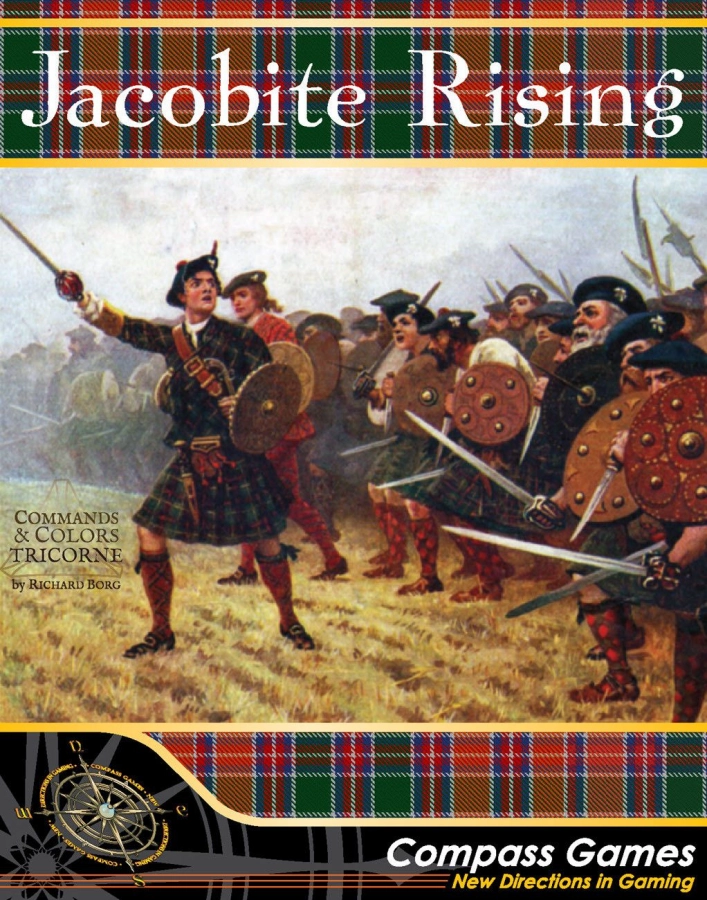Commands & Colors: Tricorne - Jacobite Rising
Pierwsza samodzielna gra dla Commands & Colours Tricorne- 2 osoby
- 60 - 90 minut
- wydanie angielskie
- Autor:
- Richard Borg
- Ilustracje:
- Nadir Elfarra, Robert Shields
- Wydawca:
- Compass Games
Opis
By design, Jacobite Rising is not overly complex. In a battle scenario, two players will command either the Jacobite forces or the units of the Government army. There are 13 battle scenarios in the game. A scenario’s battle notes state which player takes the first turn and players will alternate taking turns thereafter until one player reaches the number of Victory Banners indicated in the scenario’s victory conditions.
The Jacobite Rising battlefield game board has a hex grid of 13 hexes wide by 11 hexes deep. The battlefield is divided into three sections by two dotted lines, giving each player a Left Flank Section, a Center Section and a Right Flank Section. Where the dotted line cuts through a hex, the hex is considered to be part of both the flank section and the center section. Terrain Tiles represent a range of terrain features and are placed on the battlefield to recreate the historical scenario setting.
A Command card is played each turn by the active player to order troops on a player’s side to move, battle, or do something special. The mix of units both players may have under their commands include; regular infantry, highland infantry, lowland infantry, militia infantry, battle cavalry, light cavalry, trained artillery, light artillery and leaders. Units are represented by a group of 4 blocks in a hex and a single block represents a leader. Units and leaders may only move and battle when given an order. During a turn when units are battling, the battle dice will resolve combat quickly and efficiently and when the last block of an opposition unit or leader block is eliminated, a player will gain one Victory Banner. Again the number of banners needed to win is detailed in a scenario’s victory conditions.
In a Jacobite Rising Tricorne battle, unit morale is one of the main thematic concepts, as it was historically. It is possible that units which have taken few-- or even no- losses will run off the battefield at the first combat, which will definitely keep players on the edge of their command chairs during an entire battle.
To further emphasize the differences in battlefield doctrine between the Highland Clans and Government forces, each army has its own unique deck of Combat cards. These cards represent a mix of unit training, abilities, and surprising actions that take place during the course of a battle.
As with other Commands & Colors games, the scale of the game fluctuates, which allows players to effectively portray some of the larger historical Jacobite Rising battles, like Culloden and Falkirk, as well as smaller size skirmish actions. The 13 battle scenarios in the game present a stylized battlefield map that emphasize the important terrain features and highlights the historical deployment of forces in scale with the game system. Still the tactics of the period, that players will need to execute to gain victory, conform remarkably well to the advantages and limitations inherent to the various armies of the day and the battlefield terrain features on which they fought.
Here is the list of 13 battles and smaller skirmish actions included with Jacobite Rising:
- Killikeankie - 27 July 1689
- Dunkeld - 21 August 1689
- Cromdale - 1 May 1690
- Alness - 10 July 1715
- Sheriffmuir - 13 November 1715
- Glen Shiel - 10 June 1719
- Prestonpans - September 1745
- Clifton - 18 December 1745
- Inverurie - 23 December 1745
- Falkirk (Stage 1) - 17 January 1746
- Falkirk (Stage 2) - 17 January 1746
- Culloden - 16 April 1746
- Culloden (Flanking Move) - 16 April 1746
Rozgrywka
Podstawowe informacje
- Zawartość pudełka:
- zasady i scenariusze
- plansze
- dwustronne kafelki, znaczniki i żetony
- karty
- jednostki
- Waga:
- 3 kg
- Kod producenta:
- CPG-CCTJR
Recenzje
Pytania i odpowiedzi
Robisz zakupy pierwszy raz?
